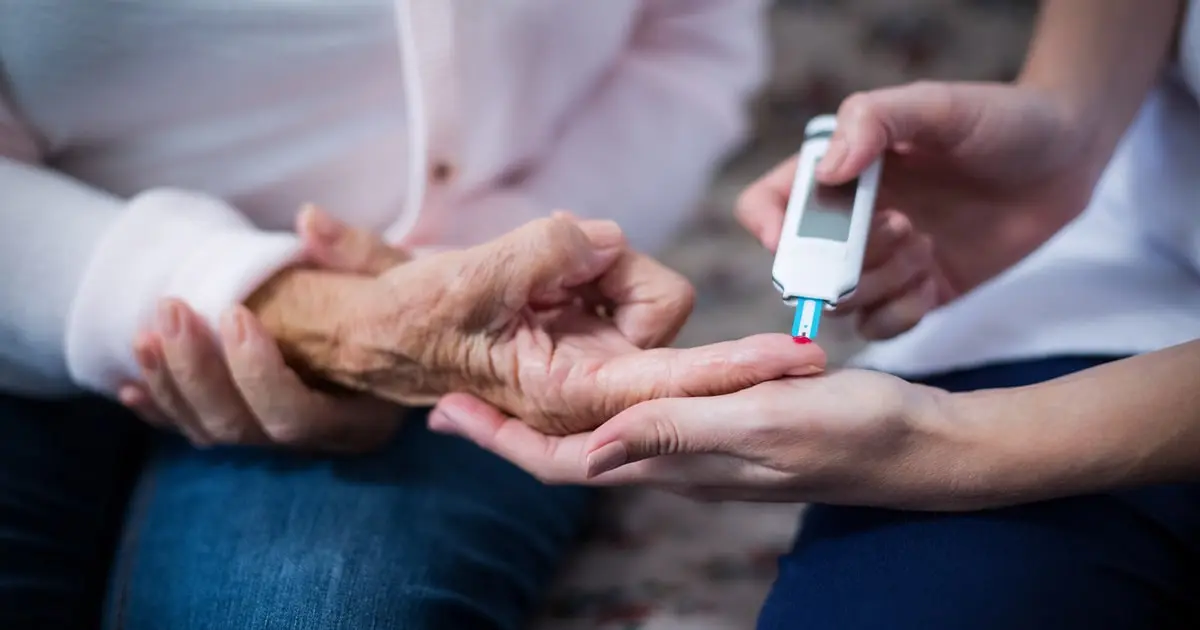
Managing Diabetes in Adults Over 80 + Tips for Daily Care
Diabetes in the elderly, or high blood sugar disease, is one of the hidden and difficult-to-treat illnesses affecting elderly people worldwide. Unfortunately, with increasing age, the risk of developing this disease rises. Nearly 33 percent of people over 65 years old are affected by diabetes. This itself highlights the importance of understanding diabetes in the elderly and caring for elderly diabetic patients. Effective management of diabetes in the elderly requires attention to their physiological changes and specific needs, especially regarding nutrition such as healthy snacks for seniors with diabetes, physical activity, and continuous blood sugar monitoring. In this article from the Human Health Mag website, we aim to examine diabetes in the elderly, focusing particularly on managing diabetes in adults over 80.
What is Diabetes?
Diabetes is a metabolic disorder in which the body is unable to produce enough insulin or cannot properly use the insulin it produces. When glucose (sugar) enters the bloodstream, the pancreas releases an appropriate amount of insulin according to the sugar level in the blood. Insulin is a hormone that allows glucose to enter the cells so the cells can use it and produce energy. If the body cannot produce enough insulin or cannot use the insulin released by the pancreas properly, the body’s metabolism is disturbed, and blood glucose levels rise. This increase in glucose over time causes various health problems and leads to different complications.
To better understand the role of insulin in the body, consider this example: insulin acts just like a key in the body. This hormone unlocks the cells so that glucose, or blood sugar, can enter them. But sometimes the lock and key don’t work properly, resulting in glucose accumulating in the blood and higher blood sugar levels in elderly people. In elderly individuals who suffer from insulin deficiency or develop insulin resistance, the body struggles to reduce the sugar from a meal after consumption.
In diabetes, whether in children or elderly adults, the body either cannot produce enough insulin or, sometimes, insulin is produced but the body cannot use it properly. When glucose enters the bloodstream, the pancreas is responsible for producing and releasing the right amount of insulin. Insulin is a hormone that causes sugar to be absorbed from the blood into the cells, allowing them to use sugar for energy production.
If insulin is not sufficient, the cells cannot receive blood sugar, causing blood sugar levels to increase. Also, since the cells cannot perform metabolism, the body’s metabolism slows down, and the patient may develop other illnesses.

Why is Managing Diabetes Different in Adults Over 80?
As people get older, their bodies change and other health problems may appear. For those over 80, managing diabetes isn’t about having a perfect blood sugar number but rather about avoiding lows and preventing complications. Older adults may have less ability to feel when their blood sugar is too low, which can lead to falls or confusion. Also, other health conditions like difficulties in walking, memory loss, or heart problems can affect diabetes care.
Common Complications
- Heart problems such as high blood pressure and heart disease
- Kidney problems including diabetic kidney disease
- Vision problems like diabetic retinopathy
- Nerve problems known as diabetic neuropathy, leading to pain, burning sensations, and loss of feeling.
- Diabetic foot: infections and wounds that heal slowly and may be treated with methods like maggot therapy
Diabetes Management in Adults Over 80
For people over 80 years old, diabetes care requires special attention and adjustments to keep blood sugar levels in a safe range while avoiding risks like low blood sugar. Managing diabetes in adults over 80 years old poses unique challenges. This age group often has multiple chronic conditions, changed physiological responses, and different lifestyle needs compared to younger adults with diabetes. Effective diabetes care for seniors must balance glycemic control with the prevention of complications like hypoglycemia, while also considering overall quality of life. In the following of this guide, we explain what diabetes management means at this age and offers simple steps to take care of health.
For managing diabetes in adults over 80, regular blood sugar monitoring, following a healthy diet, regular physical activity, and continuous medical care are essential. Education of the patient and family about symptoms and management methods is important, especially during occasions like Ramadan when diabetes in elderly people is very common.

Unique Considerations in Adults Over 80
Older adults with diabetes frequently face comorbidities such as cardiovascular disease, cognitive impairment, mobility limitations, and kidney dysfunction. These conditions impact self-care abilities and treatment choices. Thus, healthcare providers must tailor glycemic goals and treatments based on each patient’s overall health status, functional capacity, and personal preferences.
Lifestyle Modifications
Despite advanced age, lifestyle changes are foundational for managing diabetes. Nutritional counseling should avoid overly restrictive diets but focus on balanced meals that prevent large carbohydrate spikes. Exercise is important but should be adapted to physical abilities; simple activities like walking short distances indoors multiple times a day can improve glucose regulation and mobility without increasing fall risk.
Pharmacological Treatment
When lifestyle measures are insufficient, medication use is adjusted for older adults’ specific needs to minimize side effects and hypoglycemia risk. Metformin remains first-line if renal function allows, while sulfonylureas require caution due to hypoglycemia potential. Newer agents such as DPP-4 inhibitors and GLP-1 receptor agonists may offer advantages but must be used considering cost and tolerance. Insulin can be used safely with simplified regimens, typically basal insulin given in the morning to reduce hypoglycemia risk.
Monitoring and Hypoglycemia Prevention
Regular blood glucose monitoring is essential, but less stringent fasting glucose targets (90–150 mg/dL) are recommended to reduce hypoglycemia risk in this population. Avoiding overtreatment is critical, as overly tight control can lead to dangerous low blood sugar episodes. Simplifying insulin regimens, when used, helps older adults manage their dosing more safely.
Setting Safe Blood Sugar Goals
In younger adults, the goal is usually to keep blood sugar as close to normal as possible. For people over 80, doctors often recommend slightly higher blood sugar targets to prevent low blood sugar episodes, which can be dangerous. Here are common target ranges:
- Blood sugar before meals: about 100 to 150 mg/dL (5.6 to 8.3 mmol/L)
- HbA1c (average blood sugar over months): 7.5% to 8.5%
These targets can be adjusted depending on overall health, memory, ability to care for themselves, and other medical issues. For people who are frail or need help with self-care, targets tend to be more relaxed to avoid the risk of low blood sugar.
Comprehensive Care Approach
Managing diabetes in the elderly requires ongoing assessment not only of medical conditions but also psychosocial and functional status. Addressing cognitive function, social support, and mental health contributes to better self-management and overall well-being. Providers should also monitor for diabetic complications such as foot ulcers and kidney impairment, which can severely impact health in seniors.
Support and Help
Older adults may face challenges like memory problems, vision or hearing loss, and difficulty managing medicines. Family members, caregivers, or healthcare providers can support with reminders, organizing medicines, and ensuring proper meal and activity plans. Diabetes education programs designed for older adults can be very helpful to learn self-care tips and get support.

Tips for Managing Diabetes in Adults Over 80 & Daily Diabetes Care
How to avoid diabetes in old age? To reduce the risk of diabetes in the elderly, you can take the following measures:
- Eating healthy meals with a good mix of carbohydrates, proteins, and fats helps maintain steady blood sugar. Avoid skipping meals and try small, frequent meals to avoid drops in sugar. Fresh vegetables, whole grains, lean protein, and some fruits are good choices. Consuming low-calorie, high-fiber, low-fat foods such as fruits, vegetables, and whole grains can help. Avoid consuming sugars and saturated fats.
- Even gentle activity like walking or strength training for seniors over 80 at home helps insulin work better and improves overall health. Activities should be safe and adjusted to physical abilities. Exercising with support or supervision can prevent falls or injuries.
- Older adults often take many medicines, including those for blood pressure, cholesterol, or heart health. It’s important to take diabetes medications exactly as prescribed and report any side effects. Some medications may need adjustment to lower the risk of low blood sugar. Familiar medications like metformin are usually safe but need careful monitoring of kidney function.
- Regular blood sugar checks help understand how food, activity, and medicines affect levels. For some, daily checks may not be necessary, but periodic monitoring is essential to avoid very high or low sugar levels.
- Hypoglycemia or low blood sugar is more common and dangerous in older adults. Signs include shakiness, sweating, dizziness, confusion, or weakness. If these happen, eating or drinking something with quick sugar, like fruit juice or glucose tablets, helps immediately.
- Managing blood pressure, cholesterol, and regular vision and foot exams are vital because diabetes increases risks of heart problems, eye damage, and infections.
- Using smoking and alcohol can increase your risk of developing diabetes.
- Stress management techniques, such as meditation and deep breathing, help improve your overall health.

Diet for Managing Diabetes in Adults Over 80
For older adults with diabetes, a healthy diet can help control blood sugar and improve overall health. Some key points for a healthy diet for this group include:
- High in protein and fiber: Consuming lean proteins like fish, skinless chicken, and beans, as well as fiber-rich foods like vegetables, fruits, and whole grains, can help control blood sugar.
- Complex carbohydrates: Avoid simple carbohydrates like sugar and white bread and instead choose complex carbohydrates like oatmeal, whole grains, and brown rice.
- Healthy fats: Consuming healthy fats like olive oil, avocado, and nuts instead of saturated and trans fats can help keep your heart healthy.
- Avoid sugary and salty foods: Reducing your intake of sugary and salty foods can help control blood pressure and blood sugar.
- Distribution of meals: Dividing meals into several small meals throughout the day helps to better control blood sugar.
- Low-sugar drinks: Drinking water, herbal tea, and sugar-free drinks are recommended instead of sugary drinks.
- Consultation with a specialist: Consulting a nutritionist or doctor can help adjust the diet according to the individual’s health status.
Following these tips for managing diabetes in adults over 80 can help improve the quality of life of diabetic seniors and reduce the risks associated with diabetes. You should be cautious about fruits and know what fruits are harmful to diabetes.
Concluding Remarks
Managing diabetes in adults over 80 focuses on safety, comfort, and preserving quality of life. Keeping blood sugar in a slightly higher but safe range prevents dangerous lows, while balanced meals, gentle activity, and correct medication use support overall health. Support from caregivers and regular medical care contribute to living well with diabetes in older age. With the right care, people over 80 can continue to enjoy life and stay as healthy as possible.
Don’t just read; also engage and inspire! What did this post teach you, and how will you apply it? Please leave your thoughts in the comments, and let’s learn from each other!

Frequently Asked Questions
Who is more at risk for this condition?
Elderly people who are overweight, people or elderly people who smoke, do not exercise enough, or have high blood pressure, as well as some cardiovascular problems, are also among the factors that increase the risk of this disease.
What is prediabetes in the elderly?
Prediabetes means that although blood sugar is high, it is not high enough to be classified as type 2 diabetes. However, a person should start a healthy lifestyle and take steps to lower blood sugar levels. Doing physical activity, following a diet, losing weight, quitting smoking, and avoiding stress are important measures when dealing with prediabetes.
